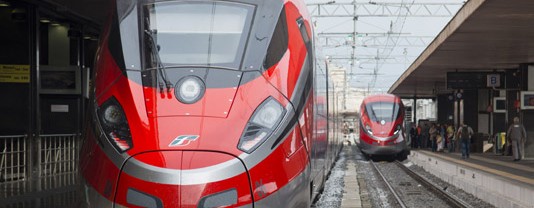Much awaited by the technicians involved, as well as by ordinary passengers, thanks to Trenitalia’s massive communication campaign, the “Frecciarossa 1000” has finally been added to the new timetable which is coming into effect on 14 JuneThe train, which is actually UIC registered as an ETR 400 (Frecciarossa 1000 is merely the commercial name chosen by Trenitalia), made its official maiden run on 25 April, a symbolic date for Italy, as it coincided with the 70th Anniversary of Liberation from Nazi-fascist dictatorship. The brand new train (for the records vehicle number 6) made a special journey from Milano Centrale to Roma Termini carrying the President of the Italian Republic, Sergio Mattarella, Transport and Infrastructure Minister, Graziano Delrio and Cultural Heritage Minister, Dario Franceschini, as well as the President of the FS Group, Marcello Messori and its CEO, Michele Mario Elia, the CEO of Finmeccanica and former CEO of the FS Group, Mauro Moretti and Lutz Bertling, President and Chief Operating Officer for Bombardier Transportation. They were joined by Manuela Olivieri, widow of Pietro Mennea, Olympic champion and 200m world record holder from 1979 to 1996, after whom the train is named. The journey, which made no intermediate stops, took just 2 hours and 39 minutes, 16 minutes quicker than envisaged. The Frecciarossa 1000 is an outstanding train for a number of reasons: it can travel at a top operational commercial speed of 360 km/h, although at this early stage “admission for entry into service” is fixed at 300km/h, the maximum operating speed allowed. However, even though it is “restricted” (for now) in terms of speed performance, this new train still makes a difference thanks to an impressive acceleration of 0.7 m/s² allowing it to reach 300km/h from stationary in just 4 minutes. A result which has been achieved thanks to 16 motors distributed along the 8 carriages, the special bogies that provide enough stability for optimum counterbalancing of the high-speed centrifugal forces, while at the same time guaranteeing maximum passenger comfort and an excellent power-to- weight ratio, achieved thanks to the special light alloys used to build the vehicle bodies and internal fittings. Designed in compliance with Technical Specifications for Interoperability (TSI), the Frecciarossa 1000 can be powered at 25 kV AC or 3 kV DC, but is also suitable for systems operating at 15 kV AC and 1.5 kV DC, for possible extension of its services over all European high-speed networks. It adopts the most advanced train operation control system, the ERTMS / ETCS, set to become the standard for all European high-speed lines in the future. The result of an investment amounting to 1.6 billion Euros by Trenitalia, the Frecciarossa 1000 offers passengers 455 seats (plus two for passengers with reduced mobility) distributed over eight carriages which are elegantly and brightly furnished (both the interior and exterior design are by Bertone), with four different levels of service to choose from: Executive, Business, Premium and Standard. We mentioned the commercial service, starts on 14 June. Initially, with the delivery of the first 8 trains (6 in service and 2 reserves), 4 pairs will run non-stop services between Rome and Milan, some of which will continue as far as Turin in the north and Naples in the south. For now journey times are the same as for “standard” Frecciarossa services provided with ETR 500 trains. As of September there will be 14 links, whereas in December, with the next timetable change, this number will rise to 22.
by Franco Tanel
Full article is available only for registered users.
Click the link below to download pdf version of Railway Engineering
